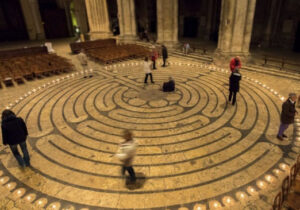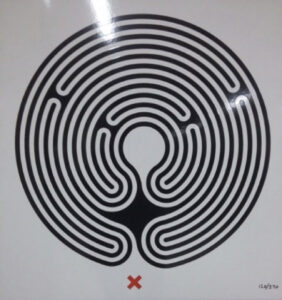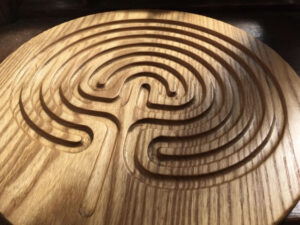By Canon Chris Palmer
“We shall not cease from exploration
And the end of all our exploring
Will be to arrive where we started
And know the place for the first time.”
From ‘Little Gidding’ by T S Eliot

In the floor of Chartres Cathedral in France is a labyrinth, perhaps the most famous labyrinth in the world. It looks a bit like a maze, but there is only one route through it to the centre – there are no dead ends; and when you get to the middle the only way out is to turn round and retrace your steps, so that you end where you began.
Labyrinths go back to antiquity. No one knows why they were adopted by Christians or what their purpose was when built into the stones of a number of continental mediaeval cathedrals. But in recent generations they have excited people’s imagination and a plethora of more recent labyrinths can be found in churches today, like the labyrinth the Dean of Exeter installed in his former cathedral in Wakefield.

They’ve also been popular in the secular world. A major art project saw a labyrinth installed in every one of London’s 270 underground stations, three of them in my former parish in Merton. And more locally there’s a turf labyrinth at Seaton in Devon.
Labyrinths are symbols and means of making a spiritual journey – they are ‘pilgrim paths’. People walk the labyrinth, or trace it with a finger, praying as they go, seeking God’s presence and guidance and grace, as on any pilgrimage. In one sense the centre is a destination – a place to arrive at and stop and be for a while. But in another sense the true destination is where you started, because at the centre you’re only half way through the journey; you need to turn round and walk home. (As an aside, we often make this mistake with other pilgrimages – walking to a shrine and then taking fast transport home; in former centuries, the slow walk home was half the experience!)
 There is no single way to pray in a labyrinth. But one way is to journey towards the centre seeking to let go of the attachments and preoccupations that keep us from God; at the centre to simply rest in God; and on the return journey to anticipate coming back to our everyday life as a new person, touched by God.
There is no single way to pray in a labyrinth. But one way is to journey towards the centre seeking to let go of the attachments and preoccupations that keep us from God; at the centre to simply rest in God; and on the return journey to anticipate coming back to our everyday life as a new person, touched by God.
We’re suggesting that making and using the labyrinth is a good activity for Thy Kingdom Come – and 10 days of prayer from Ascension Day to Pentecost. You can draw a simple labyrinth on paper, fashion it with clay, mow it into the lawn, tape it on the floor with masking tape, or mark it out with stones.
T S Eliot’s words quoted above remind us that life continually brings us back to the place from which we started. But with every ‘coming home’ we have been changed, by the tiredness, the encounters, the tasks, the joys, the long cuts (which we often call wrong turns), the resting places, and the vistas we’ve experienced on the journey. And this change allows us to see home in a new light. To walk the labyrinth is to choose to make a journey – a pilgrimage – that changes us, that lays our lives bare to God who is on the path, and is at the centre, and is ‘where we started’ – when we left and when we return.